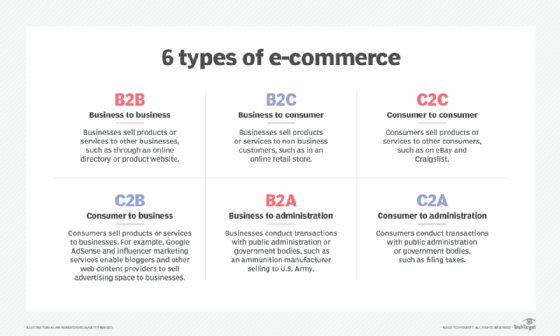
Getty Images/iStockphoto
Key steps for an e-commerce planning process
E-commerce can help organizations grow their business online, but the venture brings the most success if planned properly. These steps can start organizations on the right path.
The internet offers infinite ways to reach customers across the globe -- beyond those who can visit stores in person. In fact, some businesses operate without a single physical store.
This digital shift has been in the works for decades and, more than ever, businesses that sell goods must invest in e-commerce. Organizations that haven't shifted their sales transactions online can still make the leap to virtual storefronts, but the venture requires planning to ensure they can successfully create an online presence and guarantee ongoing success.
In addition to the resources, planning and tools required for successful virtual storefronts, businesses need to prioritize online customer interactions. Organizations must consider several key areas when they begin an e-commerce planning process.
1. Define overall goals for e-commerce
While an organization may have ambitions to increase its overall sales, e-commerce affects how it does business. Leadership teams must establish their main business goals when adopting e-commerce and determine how the new strategy will align with the company's vision and objectives. E-commerce is an extension of the organization, so if it doesn't align with business goals, the company likely won't grow or gain a wider audience.
2. Allocate resources to support e-commerce
Online sales don't always require a person to receive and process payments, so e-commerce uses resources, like automation, to process orders and address customer questions or issues. For example, FAQ pages and chatbots can answer simple questions from customers regarding order status or shipping information.
These dedicated resources can ensure customers have positive experiences, which may influence them to return.
3. Align marketing and sales strategies
The internet offers an opportunity for organizations new to e-commerce to reach customers thousands of miles away. However, this reach also means sales and marketing teams must change their strategies and embrace social media and search engine optimization to reach both prospective and existing customers online.
E-commerce sales and marketing strategies may also introduce online ads and the ability to resell products at different online marketplaces, like Amazon and eBay.
4. Define target customers and their needs
Organizations should establish their ideal online clientele. After they define their target audience, sales and marketing teams can update their efforts and campaigns to reach those individuals and support their online buying experiences.
Understanding the target audience can also influence how design teams create the organization's online catalog, as some products may require customers to customize the product or service they want.

5. Create a customer service plan
An organization's overall business strategy requires customer service, and e-commerce is no different. Organizations should establish processes and procedures to respond to customer inquiries, cancelations or general questions they receive electronically or over the phone amid the buying process.
Larger organizations may require a call or contact center to support online sales, as the volume of purchases may be high enough to require 24/7 global customer support.
6. Invest in the right technology
E-commerce software vendors have simplified implementation over the years. Many vendors, such as Shopify, offer online stores that organizations can plug and play into their existing websites.
Before businesses choose e-commerce software, they should define their e-commerce requirements, the type of catalog and overall product options they need.
7. Identify integration requirements
After an organization invests in an e-commerce platform, it must tackle integration with its existing internal systems and vendors. This process may include integrating the online store with an internal inventory system to show stock levels, a system to generate shipping labels, accounting to post all sales to a financial platform or conversion rate integration to price products for foreign currencies.
8. Create key performance indicators for online sales
Sales teams should manage and monitor online sales just like traditional storefront sales. After these teams add e-commerce to their regular funnels and forecast reviews, they must continuously evaluate online sales performance to ensure they're successful.
Online sales teams must also have targets they can evaluate to assess trends and potential changes that could be made if online purchases decline.
9. Look for continuous improvements
Leadership teams should keep up with changes in their marketplace, including new competitors, marketing channels, customers' desires and ways to improve internal operations to get products to customers quickly and efficiently.
E-commerce teams can build an online store quickly, but upfront planning can help ensure the site attracts enough sales to increase revenue. Planning also helps businesses allocate resources efficiently, understand their goals and put in place KPIs to verify that their e-commerce strategy is successful.







